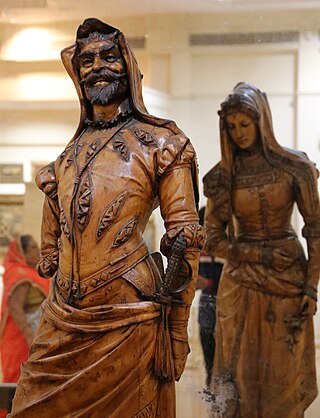Mephistopheles and Margaretta
19th-century double sculpture From Wikipedia, the free encyclopedia
Mephistopheles and Margaretta is a 19th-century wooden double sculpture featuring two images carved on opposite sides; it portrays two characters from German playwright Johann Wolfgang von Goethe's 1808 play Faust. The obverse depicts the demon Mephistopheles, and the reverse depicts a woman, Margaretta (Margaret, or Gretchen). A mirror placed behind the sculpture allows both sides to be seen simultaneously.
| Mephistopheles and Margaretta | |
|---|---|
 Mephistopheles and Margaretta, with the reverse visible in a mirror | |
| Medium | Sycamore wood |
| Subject | Characters from Goethe's Faust |
| Dimensions | 177.2 cm (69.8 in) |
| Location | Salar Jung Museum, Hyderabad, India |
Background
The statue reflects the themes of good and evil in Goethe's Faust.[1] In the play, Faust is frustrated with his life and attempts suicide. He calls for Satan's help, and the demon Mephistopheles, an agent of Satan, responds. Faust is told that Mephistopheles will serve him as long as he lives, but after his death, Faust would forfeit his soul and become enslaved forever.[2] He agrees, making a deal with the Devil, and as one of his requests for magic, Mephistopheles seduces a young woman named Gretchen (Margaretta) for Faust. She is impregnated by Faust and gives birth to their bastard son. Upon realizing the evil, Gretchen drowns her child and is subsequently imprisoned on charges of murder. She is ultimately hanged, but is granted entry into heaven; Faust is also saved by God because of Gretchen's pleadings.[2] Another literary text where the figures of Margaretta and Mephistopheles feature is The Master and Margarita by Mikhail Bulgakov, which was written between 1928 and 1940, but not published until 1966.[3]
Sculpture
Summarize
Perspective

The 19th-century sculpture was created by an unknown French sculptor, carved into a block of sycamore wood.[4] The obverse is a depiction of a confident and arrogant Mephistopheles,[5] wearing a hood and boots, and with a smirk on his face.[6] On the reverse side, Gretchen is depicted with her head bowed,[5] appearing as a simple girl with downcast eyes.[1][6]
The statue is carved from a single block of wood and is exhibited with a mirror placed behind it, allowing viewers to observe both sides at the same time.[7] The dichotomy of good and evil is emphasized by the innocence of the female figure, a demure woman holding a prayer book in her hand, contrasting with the depiction of evil exemplified by Mephistopheles.[1][4]
One of the major attractions of the museum's European Art Section, the statue is 177.2 cm tall and was presumably created in the late 19th century, in France. The sculpture represents the thin line between the duplicity of good and evil as represented by Margaretta and Mephistopheles, respectively. The male image stands proud in a hooded cloak, heeled boots and has a long, gaunt face with a cynical smile, while Margaretta is shown as a shy girl with a prayer book in her hand, and downcast eyes, lost in love.[8]
The statue was acquired by the former Prime Minister of Hyderabad Salar Jung I in 1876 during his travels in France. It is one of the most photographed exhibits of the museum.[3] The sculpture now resides in the Salar Jung Museum in Hyderabad, India.[7] The museum is one of the most visited in the country, and claims one million visitors annually.[7]
While the identity of the sculptor remains unknown, the choice of such a German archetype for a French statue reveals how post-1870, there was a surging interest in things German and topics in countries like France.[3]
See also
References
External links
Wikiwand - on
Seamless Wikipedia browsing. On steroids.
